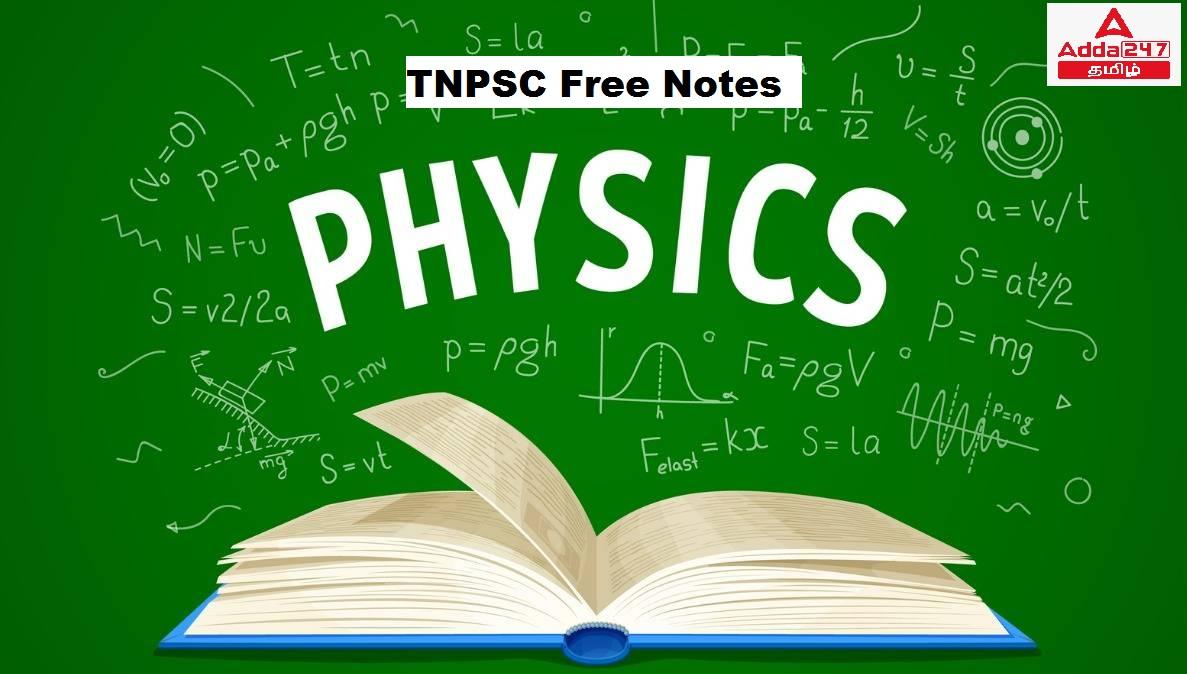இந்தக் கட்டுரையில், TNPSC குரூப் 1, குரூப் 2, குரூப் 2A, குரூப் 4 மாநிலப் போட்டித் தேர்வுகளான TNUSRB, TRB, TET, TNEB போன்றவற்றுக்கான முறைகள் இலவசக் குறிப்புகளைப் பெறுவீர்கள்.தேர்வுக்கு தயாராவோர் இங்குள்ள பாடக்குறிப்புகளை படித்து பயன்பெற வாழ்த்துகிறோம்.
Electricity:
Ohms law:
At a constant temperature, the steady current ‘I’ flowing through a conductor is directly
proportional to the potential difference ‘V’ between the two ends of the conductor.
V = I R
Not a Universal law
Not for Semiconductor
Electric Potential difference (V):
Unit – Volt
Symbol – V
Quantity – Scalar
Measuring Device
Voltmeter(closed circuit)
Potentiometer:
EMF (Open Circuit)
Voltage (Closed Circuit)
Voltage Stabilizer (to constant the voltage – Zener diode)
Transformer:
Step up
Step down
Faraday
Principle – Mutual Induction
Step up
Transformer
Step down
Transformer
Voltage V P < V S V P > V S
Current I P > I S I P < I S
Number of turns N P < N S N P > N S
Transformer
ratio
K= V S / V P = N S / N P = I P / I S
K > 1 K < 1
Electric current:
Fundamental quantity
Flow of charge
Quantity – Scalar
Unit- ampere (c/s)
Measuring device
o Galvanometer(small)
o Ammeter
Types of current:
Alternating current:
o Sinusoidal wave
o F = 50Hz (India)/60Hz (USA)
o V = 220V (India)/110V (USA)
o T = 0.02sec
o Induction(henry)
Direct current:
o constant current
o Frequency = Zero
o Time period=Infinity
Charge carriers:
Conductors – electrons
Semiconductors – Holes and electrons
Electrolyte – Ions (cations and anions)
Electric Charge:
Attraction or Repulsion
Unit – coulomb
Quantity – Scalar
Measuring device – Electroscope
Storage device – capacitor-capacitance(farad)
1F = 96500 coulomb = 96500 x 6.253×10 18 electrons
Basic units of charge:
Electric charge = ±1.6 x10 –19 C.
1coulomb = 1/(1.6 x 10 -19 ) = 6.253×10 18 electrons
Electric field:
The lines representing the electric field are called ‘electric lines of force.
The electric lines of force are straight or curved paths along which a unit positive charge
tends to move in the electric field.
Resistance and conductance:
Resistivity and Conductivity:
Resistance is directly proportional to length of the conductor and inversely proportional
to the cross section area of the conductor.
R = ρ (L/A)
L = length of the conductor
A = area of cross section.
ρ = resistivity
Unit – ohm metre
Conductance = reciprocal of its resistance (R).
Unit = mho or ohm – 1
The conductivity is reciprocal of electrical resistivity of a material.
Unit – is ohm – 1 metre – 1
Resistance in series and Parallel:
Current constant
Voltage differs
R TOTAL = R 1 + R 2 + R 3
R TOTAL > R MAX
Galvanometer and Ammeter
Fuse wire connect in series
Resistances in parallel:
Voltage constant
Current varies
Voltmeter and potentiometer
1/R TOTAL = 1/R 1 +1/R 2 +1/R 3 …1/R n
R TOTAL < R MIN
Effects of Electric Current:
Heating effect
Magnetic effect (Magnetism)
Chemical effect
Heating effect of current:
Discovered by joule.so it is called as jolu’s law of heating
H = I 2 RT
H = Amount of heat produced
I = Current
R = Resistance
T = Time
Wires:
Red wire – live wire
Black wire – neutral
Green wire – earthing
Nichrome – nickel + chromium
High melting point
High resistivity (1.5X10 – 6 Ω m)
Bulb filament – tungsten
High melting point
High Resistivity
Fuse wire – lead + tin
Low melting point
High Resistivity
Chemical effect of current:
Cells-used to create potential difference in the circuit.
Primary cells – non reachargable
Secondary cells – rechargeable
Electric Power:
P = 1 volt x 1 ampere = 1 watt
1 kWh = 1000 watt hour = 1000 (60 60) watt second = 3.6 10 6 J
Horse Power:
The horse power is a unit in the foot – pound – second (fps) or English system, sometimes
used to express the electric power. It is equal to 746 watt.
**************************************************************************
| Adda247 TamilNadu Home page | Click here |
| Official Website=Adda247 | Click here |




